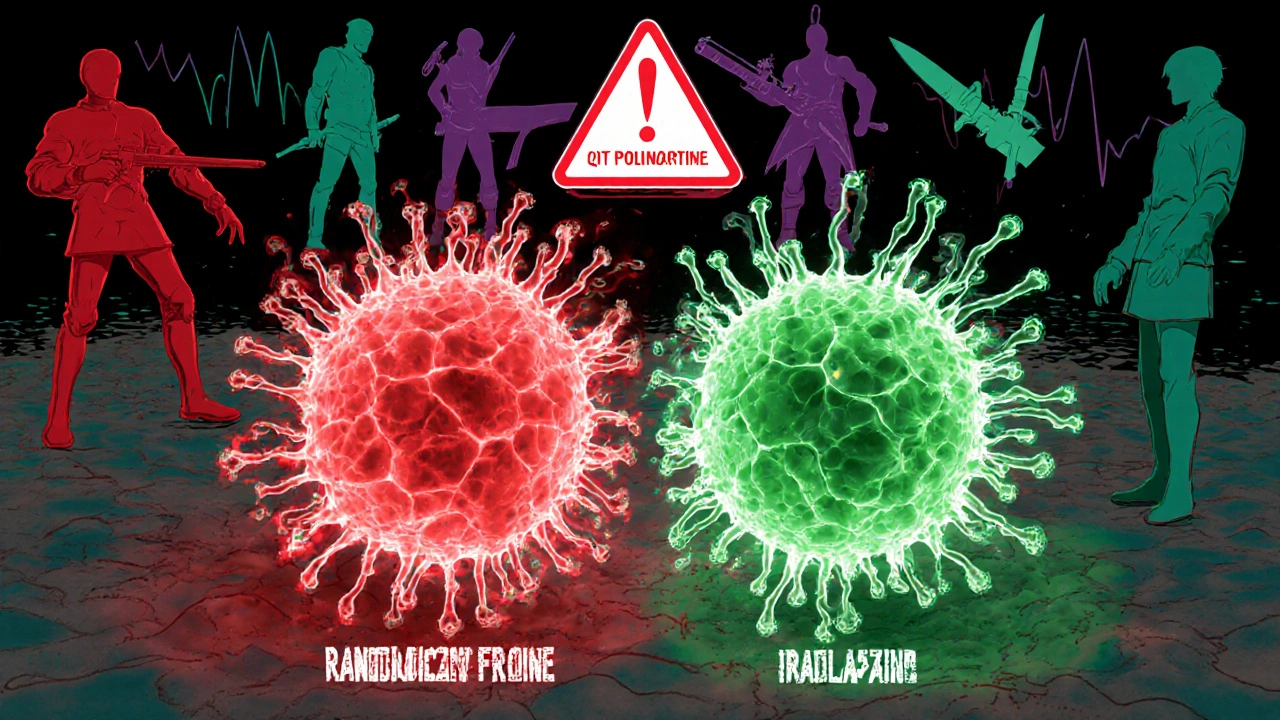When you’re living with chronic angina, every chest tightness or shortness of breath can feel like a warning sign. Ranexa (ranolazine) was approved in the U.S. in 2006 and in Australia in 2008 as a second-line treatment for people who still have symptoms despite taking standard meds like beta-blockers or calcium channel blockers. But it’s not the only option. Many patients wonder: Ranexa works for some, but is it the best for you? And what else is out there?
How Ranexa Actually Works
Ranolazine doesn’t lower your heart rate or blood pressure like most angina drugs. Instead, it targets how heart muscle cells use energy. In ischemic heart tissue-where oxygen is low-cells switch to less efficient ways of making energy, which leads to buildup of harmful waste products and triggers chest pain. Ranolazine blocks a specific sodium channel (INa) that’s overactive in these stressed cells. This helps the heart use oxygen more efficiently, reducing the frequency and severity of angina attacks without affecting heart rate or blood pressure.
That’s why it’s often used alongside other meds. In clinical trials, patients on ranolazine had about 1.5 fewer angina episodes per week compared to placebo. It also improved exercise tolerance by around 30 seconds on average. But it doesn’t reduce heart attacks or death risk. That’s key: it treats symptoms, not the underlying disease.
Common Alternatives to Ranexa
There are three main classes of drugs used before or instead of ranolazine for chronic angina:
- Beta-blockers (e.g., metoprolol, atenolol, carvedilol)
- Calcium channel blockers (e.g., amlodipine, diltiazem, verapamil)
- Nitrates (e.g., isosorbide mononitrate, nitroglycerin)
Each works differently. Beta-blockers slow the heart and reduce its workload. Calcium channel blockers relax blood vessels and reduce heart muscle contraction. Nitrates widen arteries to improve blood flow. These are first-line treatments because they’ve been used for decades, are cheap, and have strong evidence for reducing both symptoms and long-term risk.
Comparing Ranexa to Beta-Blockers
Beta-blockers are the go-to for most people with angina. They’re effective, widely available, and often covered by insurance with low copays. But they come with side effects: fatigue, dizziness, cold hands, and sometimes depression or sexual dysfunction. If you’re already on a beta-blocker but still having chest pain, adding ranolazine might help-especially if you can’t tolerate higher doses.
One study published in The New England Journal of Medicine in 2006 showed that adding ranolazine to a beta-blocker reduced angina episodes by 38% compared to placebo. But ranolazine alone isn’t as effective as a full dose of metoprolol or carvedilol. So if you’re not on a beta-blocker yet, starting with one is usually better.
Also, ranolazine can’t be used if you have liver problems. Beta-blockers can be risky in people with asthma or severe heart failure. So your choice depends on your other health conditions.
Ranexa vs Calcium Channel Blockers
Calcium channel blockers like amlodipine are often used if beta-blockers don’t work or cause side effects. They’re great for people with high blood pressure too. Amlodipine, for example, is taken once daily and has fewer side effects than older versions like verapamil.
Ranolazine doesn’t lower blood pressure, so if you’re already on a calcium channel blocker for hypertension, adding ranolazine won’t interfere. But if your main issue is angina without high blood pressure, a calcium channel blocker alone might be enough.
Some patients who can’t take beta-blockers due to asthma or slow heart rate are switched to calcium channel blockers. If those don’t fully control symptoms, ranolazine is the next step. But it’s not a replacement-it’s an add-on.

Nitrates: Fast Relief vs Long-Term Control
Nitrates like nitroglycerin tablets or sprays are used for immediate relief during an angina attack. Isosorbide mononitrate is taken daily to prevent attacks. But tolerance builds quickly-you need a daily “nitrate-free” window to keep them working.
Ranolazine doesn’t cause tolerance. That’s a big advantage. If you’re using nitrates multiple times a day and still having symptoms, ranolazine can help reduce your reliance on them. But nitrates are faster acting. You can’t swap one for the other; they serve different purposes.
Other Options: What About Newer Drugs?
There’s ivabradine, approved in Australia and Europe for angina in patients with a high resting heart rate. It slows the heart’s natural pacemaker without affecting blood pressure. It’s not a first-line drug, but for people who can’t take beta-blockers and have a heart rate over 70 bpm, it’s a solid alternative.
Then there’s trimetazidine, used in Europe and Asia but not approved in the U.S. or Australia. It works similarly to ranolazine by improving heart energy efficiency. Some studies show it’s as effective as ranolazine, but it’s not available here. If you’re traveling or have access to it through special programs, it’s worth discussing with your doctor.
Side Effects: What You Need to Know
Ranolazine’s most common side effects are dizziness, constipation, nausea, and headaches. These usually fade after a few weeks. But there’s one serious risk: QT prolongation. This is a change in the heart’s electrical rhythm that can lead to dangerous arrhythmias, especially if you’re on other drugs that affect the heart’s rhythm-like certain antibiotics, antifungals, or antidepressants.
That’s why doctors check your ECG before starting ranolazine and avoid it if you have liver disease or are on strong CYP3A4 inhibitors like clarithromycin or ketoconazole. Beta-blockers and calcium channel blockers have their own risks, but they’re better understood and easier to monitor.
Cost and Accessibility
In Australia, ranolazine is listed on the PBS (Pharmaceutical Benefits Scheme) with a subsidy, but it’s still more expensive than metoprolol or amlodipine. A 30-day supply of ranolazine costs around $30 after subsidy. Generic metoprolol? About $5. Isosorbide mononitrate? $7. If cost is a major factor, starting with a first-line drug makes sense.
Insurance in the U.S. often requires step therapy-you must try and fail on beta-blockers or calcium channel blockers before covering ranolazine. That’s standard practice because the evidence shows those drugs are more cost-effective for most people.

Who Should Consider Ranexa?
Ranolazine isn’t for everyone. It’s best for:
- People with chronic stable angina who still have symptoms on max doses of beta-blockers or calcium channel blockers
- Those who can’t tolerate beta-blockers due to asthma, low heart rate, or depression
- Patients who need symptom control without lowering blood pressure or heart rate
- Those who use nitrates frequently and want to reduce dependency
It’s not recommended if you have:
- Severe liver impairment (Child-Pugh Class C)
- QT prolongation on ECG
- Are taking strong CYP3A4 inhibitors
- Have unstable angina or recent heart attack
Real-Life Scenarios
Meet Sarah, 62, from Geelong. She’s on metoprolol 100mg daily but still gets chest tightness walking up hills. Her doctor adds ranolazine 500mg twice daily. After two weeks, her episodes drop from 4-5 times a week to once every 10 days. She doesn’t feel fatigued like she did on higher metoprolol doses.
John, 70, has COPD and can’t take beta-blockers. He’s on amlodipine, but still has angina. His cardiologist adds ranolazine. His symptoms improve, and he avoids nitrates entirely. He’s now on two drugs instead of three.
Both cases show ranolazine’s value-but only after first-line options were tried.
Bottom Line: Where Does Ranexa Fit?
Ranexa (ranolazine) isn’t a first-choice drug. It’s a precision tool for a specific group: those who’ve tried the basics and still struggle. It doesn’t replace beta-blockers or calcium channel blockers-it complements them. It’s not cheaper, not faster, and not more life-saving. But for people with persistent angina who need symptom relief without side effects from other drugs, it’s a real option.
If you’re still having chest pain on standard meds, talk to your doctor about whether ranolazine makes sense for you. Don’t assume it’s better just because it’s newer. The oldest drugs are often the most reliable.
Is Ranexa better than beta-blockers for angina?
No, Ranexa is not better than beta-blockers as a first treatment. Beta-blockers like metoprolol reduce heart workload and lower the risk of heart attacks. Ranexa only helps with symptoms and doesn’t improve survival. It’s used when beta-blockers aren’t enough or cause side effects.
Can you take Ranexa with a calcium channel blocker?
Yes, Ranexa is often combined with calcium channel blockers like amlodipine or diltiazem. They work in different ways, so together they can provide better symptom control. Your doctor will monitor for side effects like dizziness or low blood pressure.
Does Ranexa lower blood pressure?
No, Ranexa doesn’t lower blood pressure. That’s one reason it’s useful for people who need angina relief but can’t tolerate drugs that cause dizziness or low BP. It works by improving how the heart uses oxygen, not by changing blood pressure.
Is there a generic version of Ranexa?
Yes, generic ranolazine is available in Australia and the U.S. It’s chemically identical to Ranexa and costs significantly less. Many pharmacies stock it under the name "ranolazine"-ask your pharmacist.
What are the most common side effects of Ranexa?
The most common side effects are dizziness, constipation, nausea, and headaches. These usually improve after the first few weeks. A rare but serious risk is QT prolongation, which can cause irregular heartbeats. Your doctor will check your ECG before and during treatment.
Can Ranexa be used after a heart attack?
No, Ranexa is not recommended for people who’ve had a recent heart attack or have unstable angina. It’s only approved for chronic stable angina-where symptoms are predictable and not worsening. Using it too soon after a heart event can be unsafe.
How long does it take for Ranexa to start working?
Most people notice fewer angina episodes within 1-2 weeks. Full effects usually take 4-6 weeks. It’s not a fast-acting drug like nitroglycerin. It’s meant for daily prevention, not immediate relief.
Next Steps: What to Do If You’re on Ranexa
If you’re already taking ranolazine:
- Keep track of how often you have chest pain and what triggers it
- Report any new dizziness, fainting, or irregular heartbeat right away
- Don’t start new medications (even OTC or herbal) without checking with your doctor
- Ask about getting a repeat ECG every 6-12 months if you’re on long-term therapy
If you’re considering switching from another drug to ranolazine:
- Make sure you’ve tried and optimized first-line options
- Discuss your lifestyle-can you increase exercise or manage stress better?
- Ask if a different beta-blocker or calcium channel blocker might work better before adding another drug
Chronic angina is manageable. But the goal isn’t just to reduce symptoms-it’s to keep your heart healthy long-term. Ranexa has a place in that plan, but only if used the right way.





Jennifer Skolney - 19 November 2025
I’ve been on Ranexa for 8 months now, and honestly? Life-changing 😊 I was on metoprolol but kept getting dizzy and exhausted. Ranexa let me walk my dog without stopping every 5 minutes. No BP drop, no fatigue-just peace. My cardiologist said it’s not a cure, but for symptom control? Perfect.
JD Mette - 19 November 2025
Thanks for sharing this breakdown. I’ve seen so many people assume newer = better, but the reality is more nuanced. First-line drugs work because they’ve stood the test of time. Ranexa has its place, but it’s not a magic bullet. I appreciate when posts don’t oversimplify.
Olanrewaju Jeph - 20 November 2025
As a medical professional from Nigeria, I’ve encountered trimetazidine more frequently than ranolazine. It’s equally effective in improving myocardial efficiency, and it’s significantly cheaper. Unfortunately, regulatory barriers prevent its use in the U.S. and Australia. Patients who travel or have access to international pharmacies should discuss this option with their providers. The mechanism is nearly identical to ranolazine, with fewer drug interactions.
Also, the point about QT prolongation is critical. Many patients aren’t aware that common antibiotics like azithromycin can interact dangerously. Always disclose all medications-even supplements like St. John’s Wort.
Dalton Adams - 21 November 2025
Let’s be real-ranolazine is just a fancy Band-Aid for people who won’t do the hard work. Beta-blockers have been proven to reduce mortality. Ranexa? Zero impact on survival. It’s a $300/month placebo with side effects. And don’t get me started on trimetazidine being banned in the U.S. because the FDA doesn’t trust non-American pharma. Classic. Also, if you’re still having angina after maxing out beta-blockers, maybe you need a stent, not a new pill. Just saying.
Also, Karla, your emoji game is weak. 🤡
Kane Ren - 22 November 2025
Hey, if you’re struggling with angina, don’t give up. I was skeptical about ranolazine too-but after 3 weeks, I could climb stairs without gasping. It’s not glamorous, but it’s real. Your heart deserves a break. Talk to your doc, track your symptoms, and don’t let cost scare you off. Generic ranolazine is way cheaper than people think. You’ve got this 💪
Charmaine Barcelon - 22 November 2025
STOP. Just STOP. Ranexa is NOT for everyone. You’re not special. You don’t need it. You just need to take your beta-blocker like you’re supposed to. And if you’re still having pain? Maybe you’re not taking it right. Or maybe you’re eating too much salt. Or maybe you’re not exercising. You’re not a victim. You’re just lazy. And don’t even get me started on trimetazidine-it’s not FDA-approved for a reason!!!
Karla Morales - 23 November 2025
Based on the pharmacokinetic profiles and the 2006 NEJM trial data, ranolazine demonstrates a statistically significant reduction in weekly angina frequency (p < 0.001), yet shows no mortality benefit (HR 1.02; 95% CI 0.89–1.17). This aligns with its mechanism as a metabolic modulator rather than a hemodynamic agent. The absence of blood pressure or heart rate modulation makes it uniquely suitable for patients with comorbid hypotension or bradycardia. However, CYP3A4 inhibition remains a critical contraindication-particularly with macrolides and azole antifungals. I recommend ECG monitoring at baseline and 4–6 weeks post-initiation. Trimetazidine remains a compelling off-label alternative in regions where access permits.
Javier Rain - 25 November 2025
Love this breakdown. Seriously. Ranexa isn’t the hero, but it’s the sidekick that saves the day when the main team is exhausted. I’ve seen patients who couldn’t tolerate beta-blockers because of asthma or depression-and ranolazine gave them back their lives. It’s not about being the best-it’s about being the right one. And yes, generic is available. Ask your pharmacist. Don’t let insurance gatekeeping stop you from asking for what works.
Laurie Sala - 25 November 2025
But what if… what if it doesn’t work? What if I’m the one who tried everything and still can’t walk to the mailbox? What if I’m tired of being told I’m not trying hard enough? I’m not asking for a miracle-I’m just asking for relief. And now they’re telling me I have to pay $30 a month for something that might not even help? Why does everything have to be so hard?
Lisa Detanna - 26 November 2025
Hey Laurie-I hear you. It’s not fair. And you’re not alone. I’ve been there too. The system makes it feel like you’re failing when you’re just surviving. Ranexa isn’t perfect, but for some of us, it’s the only thing that lets us breathe without fear. Don’t let anyone make you feel guilty for needing help. Your pain is real. And you deserve to feel better.